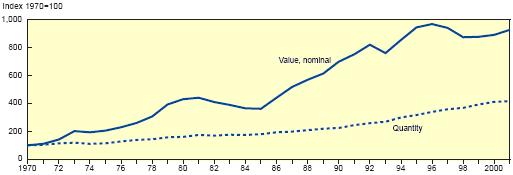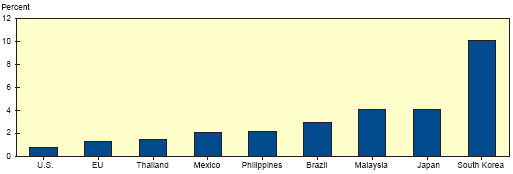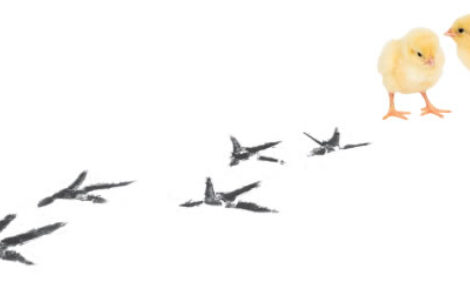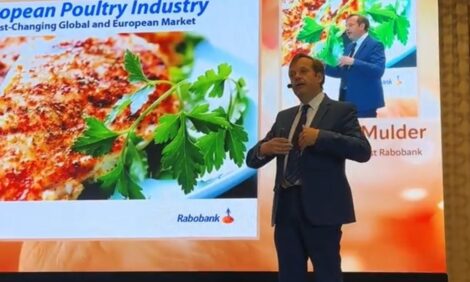



Current Structure of World Meat Trade
By John H. Dyck and Kenneth E. Nelson. This is the fifth article in the series taken from the Economic Research Service's Structure of the Global Markets for Meat report. To read the other articles in this report, see the Further Sections table below.
International meat trade has a long history, but recent decades have seen fast growth of trade volume and value (fig. 7). Reductions in protectionism are one reason. Associated with the reduced protectionism, either as causal factors or as consequences of liberalized trade, are important changes in diets, distribution technology, and multinational business structures. Understanding the significance of these factors is necessary in order to understand the current structure of world meat trade and its future evolution.
Dietary Changes Associated With Economic Development
Economic development brings with it increased household income and urbanization. With increased
incomes, households can purchase more food and higher valued foods, such as meat (Regmi et al.).
Urbanization (which can also occur in the absence of economic growth) increases household access to meat sold in shops and brings changes in occupational and household structure that favor consumption of food away from home, including meat.
| Ad Valorem Tariff Equivalents | ||
For instances in which a tariff is not in percentage, or ad valorem, terms, an ad valorem equivalent of the tariff is desirable when comparing protection across countries and commodities. In table 2, there are six instances in which the duty applied at the border is not in simple ad valorem terms.
|
The importance of dietary changes to meat imports is shown by the case of Japan, the world’s largest importer of beef and pork, both in value and volume. Japan’s import growth reflected the rapid increase in meat consumption that occurred there between 1960 and 1995, when consumption/person increased almost sixfold. Japan’s national diet changed during that period, a time of growing affluence, urbanization, and exposure to global trends. Caloric intake increased, and calories from meats replaced calories from rice and other traditional foods. Consumption increased faster than production, and imported meat supplied the difference.
While meat consumption growth appears to have leveled off in Japan in the late 1990s, meat consumption is currently growing in major parts of the developing world—East, Southeast, and South Asia, the Middle East, Mexico, and South America—as development proceeds (fig. 8). As in the case of Japan, the growth in meat consumption pushes up prices of domestically produced meat, and increases the possibility of a market for imported meat.
| Figure 7: World meat exports, 1970-2001 | ||
 |
||
| Source: FAOSTAT, 4/15/03. | ||
Technology of Distribution
Meat has a short usable shelf-life, unless it is preserved. However, for many purposes, fresh meat is preferred in markets around the world. Frozen meat has uses in the restaurant and food processing businesses, but households in most developed countries generally prefer to buy fresh meat, unless the meat is prepared for easy serving. Chilled meat, which is kept at quite low temperatures but never frozen, is a close substitute for fresh meat and has a longer shelf-life. Opportunities to ship chilled meat increased in the 1990s. With current technology, beef and pork can both be shipped long distances (e.g., across the Pacific) in chilled rather than frozen form. Because of its shorter shelf-life, poultry meat can only be shipped in chilled form for relatively short distances.11
Japan has been at the center of much of the transition from trade in frozen meat to trade in chilled meat. Taiwan’s shipments of chilled pork to Japan began in the 1970s. In the 1980s, Australian exports of chilled beef to Japan opened a major new flow of beef to Japan, followed quickly by chilled shipments from the United States of both beef and pork.12 Even for poultry meat, which has the shortest shelf-life, a significant trade in chilled meat opened up in the late 1990s from China to Japan. New technology (especially controlled-atmosphere refrigerated containers, vacuum packing, and improved microbial control) has lengthened the time in which meat can be kept marketable and encouraged transoceanic trade in chilled meat by ship.
Japan is also pioneering the import of prepared (ready to heat and serve) meat entrees, instead of meat cuts for cooking or further processing. These prepared products are being sourced in China, Thailand, Brazil, and the United States. Such product additions to the meat trade potentially increase the complexity of trade patterns, because they increase the possibilities for shifting processing operations to countries where labor is relatively abundant from countries where processing labor is expensive.13 Frozen poultry meat, for example, has been shipped from the United States to China, where it is cut up and used in meat preparations sent to Japan.
| Figure 8: Average annual change in meat consumption per person, 1964-1999 |
||
 |
||
| Source: FAOSTAT. | ||
Multinational Business Structures
Hundreds of firms of all sizes engage in world meat trade, but a few very large firms are clear market leaders. These firms tend to be important meat firms in their home countries, and to sell and/or produce meat in more than one foreign country. Of the 10 firms with the largest meat sales, seven are headquartered in the United States, and one each in Switzerland, Japan, and Denmark (table 3). Firm-level trade data are not available, but the high share of meat production by the U.S. and Danish firms in their home countries indicates that their share of meat exports must also be high.
A larger, international market may enable increases in plant and firm size that lead to economies of size. As a firm sells to a larger market, its costs per unit of meat fall because it can expand its size of operation. Seen from another perspective, large firms can deliver larger orders of meat of consistent quality, more often, and at lower cost than smaller firms, and thus are successful in competing for export markets. Their size also allows them to establish sales offices in foreign markets. Exports act as an extension of the market into which a firm sells meat. By expanding the potential consumer market, exports can justify the construction of larger slaughter/processing plants and/or the more intensive use of such plants allowed by adding shifts to plant operation. The success to date of the largest firms in world trade is likely linked to their ability to achieve economies of size that let them compete on the basis of price while providing meat of a variety of types, in large units, at consistent levels of quality. Firms may also realize economies of scope (for example, realizing cost savings by providing centralized management, sales force, or research to several operations). In general, large firms dominate first the meat markets of countries with large populations, then reach out to foreign markets to attain better prices for cuts and byproducts than can be realized in their home markets.
Examples of the success of large firms in global meat markets include Denmark’s Danish Crown, the ninthlargest meat company. Danish Crown produces most of its meat in Denmark, but, with a population of about 5 million, the Danish domestic market absorbs only a fraction of the firm’s output. The rest is shipped, in cuts, throughout much of Europe and to North America and East Asia. The ability to trade has allowed Danish Crown to increase the size and number of its meat plants (and Danish hog farms to increase herd size). Like Danish Crown, the Brazilian meat firms Sadia and Perdigao are major meat exporters. These firms have grown large selling poultry and pork to the populous domestic market, and have become major poultry exporters to Japan, the Middle East, Europe, and other parts of South America.
Firms can also take advantage of differences in meat cut preferences. Shipping a cut to a foreign market where it commands a higher price can increase a firm’s net returns. Transportation and distribution costs may be lower for larger quantities and more frequent shipments. Thus, large firms which can reliably and consistently produce large quantities of cuts (or byproducts) may have a competitive edge over smaller firms in supplying such cuts.
Eight of the 10 largest firms export meat from their home market (the exception are the Japanese and Swiss firms). By reducing costs in the supply chain, through exploiting economies of size, and by satisfying differentiated international demand for cuts and byproducts, these firms are evidently able to increase net returns from processing animals.
A number of meat firms have become multinational producers, investing in animal production and/or processing in one or more foreign countries. Among the U.S. firms, Swift controls the largest meat firm in Australia, and Cargill, IBP (purchased by Tyson in 2001), and Smithfield are major producers of pork and beef in Canada. Smithfield also produces pork in Mexico, Brazil, and Poland. Pilgrim’s Pride (with U.S. ownership) is the second-largest broiler company in Mexico. Tyson and Perdue produce poultry products in China, and Tyson also has large poultry production in Mexico. The Charoen Pokphand companies, originating in Thailand and Hong Kong, are active in meat production throughout much of Asia.
The decision to invest in production in another country or to simply export to that country is influenced by the possibilities for increasing returns to plant size — which could encourage expanding a plant’s operation to ship exports out — and possibilities for increasing returns to a firm’s scope — which could encourage setting up production or sales in a foreign country in order to get more use out of existing management and marketing efforts (Bredahl). Another reason for multinational operation may be the opportunity to extend technologies or management practices to a country where they are not yet in use, and to capture profits as an early adopter of these methods.
Japan’s largest meat firms produce meat both in Japan and in exporting countries (the United States, China, and Australia) for shipment to Japan as well as to other markets. Importing lower cost meat produced in foreign markets allows the Japanese firms to offer competitive prices in Japan while controlling cutting specifications to use those best suited for Japanese consumers.
Summarizing the Current Structure of Meat Trade
Using volume data to summarize national trade flows by meat type, we can create a snapshot of the current structure of the global meat trade. In beef, the largest exporters by volume are Australia, the United States, and, until 2001, the EU (fig. 9). The United States is the largest importer by volume, followed by Japan (fig. 10). The largest pork exporters are the EU, Canada, and the United States (fig. 11). Japan is the largest pork importer, followed by Russia and the United States (fig. 12). In poultry meat, the United States dominates world exports, followed by Brazil, the EU, China, and Thailand (fig. 13). Major importers are Russia, China and Hong Kong, and Japan (fig. 14).
If we define beef, pork, and poultry each as industries, then we observe intra-industry trade within the meat types. The United States is both an importer and exporter of beef and pork; China is both an importer and exporter of poultry. In part, the intra-industry trade reflects large differences within a meat group, such as beef, in production practices and quality. Grain-fed beef production uses high-energy feeds to achieve weight gain, and the meat derived from it is relatively tender because of increased levels of intramuscular fat. In the United States and Japan, grain-fed beef has uses for which grass-fed beef would not be suitable. The United States and Canada import grass-fed beef — combining it with domestic beef to make hamburgers with desirable levels of fat content—while exporting grain-fed beef.
Other intra-industry trade, however, reflects trade in cuts based on differences in demand, such as U.S. imports and exports of pork and offal, China’s imports and exports of chicken, imports and exports of pork and offal by Korea and Taiwan. While trade in all three major meats has increased, poultry meat trade has grown the most, and now is the largest meat trade flow by volume. The case of U.S.-China poultry meat trade, already mentioned, is the best illustration of preference differences in demand. China exports legs and a variety of processed chicken meat cuts to Japan, but imports chicken feet, wings, and edible offal. U.S. exports to Mexico and Russia also reflect disparate demand for cuts, particularly in the poultry meat sector. Much of the great outpouring of poultry meat exports from the United States is the reflection of the U.S. affinity for white meat, especially breast meat. Growing more and more broilers for breast meat, U.S. suppliers have turned to foreign markets to sell dark meat, offal, and feet at a higher price than within the United States.
Disease status is reflected in figures 9-14 as well. China’s exports of chilled and frozen pork have not grown during a period (1985-2001) when global pork trade grew, perhaps mainly because China’s non FMDfree status inhibits producers from shipping pork to important markets such as Japan (fig. 11). Similarly, Taiwan, at times the world’s second-largest pork exporter in the early 1990s, has been virtually shut off from exports because of FMD. Argentina and Brazil have failed to capture much of the growth in world trade in chilled and frozen beef, in part because of recurring FMD problems that blocked trade to major importing countries (fig. 9). The decline in EU beef exports in the late 1990s was due in part to disease problems with BSE and FMD.
Large industrial meat firms are connected to at least some, and perhaps all, of the major meat export flows in figures 9, 11, and 13. This is especially true in the United States, Canada, and Australia for beef; the EU, the United States, Canada, Taiwan, and Brazil for pork; and the United States, EU, Brazil, and Thailand for poultry meat. A few large firms coordinate most of Japan’s meat imports. The association of large firms — maintaining large-scale processing plants—with meat trade is consistent with the idea that economies of size can enhance competitiveness in global meat trade.
The underlying influence of the resource base for meat production is easier to observe after the factors above—intra-industry trade, disease status, and industrial structure —are taken into consideration. In all three meat types, North America, with its grain and oilseed surpluses, plays a leading role in exports. Brazil, where strength in oilseeds and adequate grain and pastureland unite with low labor costs and large-scale firms, is a significant exporter of all three meats, and the secondlargest poultry meat exporter. All the leading beefexporting nations, with the exception of the EU, have large pasture bases, and all, with the exception of New Zealand, have large grain production.
Among the beef-importing countries, resource base appears at first glance not to matter: the United States, Canada, and Russia have good land for pasture and grain production, and the EU produces abundant grain. However, as explained earlier, North American pastureland is used to support a grain-fed cattle industry, and imports consist of grass-fed beef. Russia’s economy and agriculture are in transition, and the institutions supporting livestock and meat markets may develop in the future, leading to more beef production in Russia—but this has not happened yet. The EU imports and exports beef with its current, highly protective policies. These policies may mask a resource situation that indicates that Europe could be a net beef-importing region.
In pork and poultry meat, the trade figures show some countries with high grain or oilseed production exporting meat (the United States, Canada, Eastern Europe, the EU, China, Brazil, Thailand) and others with a low production of feedgrain and oilseeds (Japan, Hong Kong, Korea, Saudi Arabia) importing meat. This corresponds well with resources available for meat production. Some anomalies can be explained. Taiwan was a leading pork exporter because of lower labor costs, proximity to Japan, the fact that it was one of the world's few areas free of FMD (until 1997), and preference differences that made exporting cuts to Japan profitable. China's imports of poultry meat are based on preference differences, as noted earlier. Mexico has a deficit in feedgrains (despite considerable grain production) and oilseed meals. Russia, as in the case of beef, seems to have the land resources for greater meat production, but markets have not yet harnessed those resources. Furthermore, Russian imports of poultry meat are often lower priced dark meat from the United States.
Source: U.S. Department of Agriculture, Economic Research Service - September, 2003








